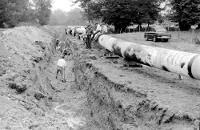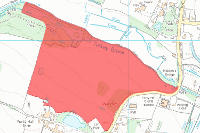01 Apr 2015
Forty Hall Rescheduled
As you may have read in the news, today marks the first day of Historic England -- the newly created public body charged with the protection of England's historic places.
This coincides with the news this week that the entry in the Schedule of Ancient Monuments for the site of Elsyng Palace in Forty Hall has been updated, significantly increasing the protected area of the park, thanks in no small part to the work done by the EAS over the last ten years.
When the palace site was rediscovered by the Society in 1963, it was immediately clear that Elsyng represents a unique and nationally significant archaeological monument, not only as the site of an early Tudor courtier's palace later developed by Henry VIII, but as a complex multi-phased site with a rich history stretching back at least four centuries earlier.
One of the key features of the site is the fact that it has remained almost entirely undisturbed since its final demolition in the mid-seventeenth century, making the often shallowly-buried palace remains exceptionally well preserved.

The notable exception to this was the installation of a large gas main in 1968: Unfortunately, this came early in the research history of the palace and the exact nature and extent of the palace complex were poorly understood. Consequently, the chosen route of the gas main did not, as intended, miss the palace remains, but cut a slot straight through the remains of several buildings (pictured).
While the damage done was significantly less than might have been without EAS intervention, it was enough to spur official action and led soon afterwards to the site receiving statutory protection, which it has enjoyed to this day under the Scheduled Monuments and Archaeological Areas Act 1979.
While this has successfully preserved the site for the last 47 years, the area chosen for protection was based on the best information at the time, which was as mentioned above, very incomplete. It was largely in recognition of this that the new EAS research programme began in 2004, to try and fill in the many gaps in our knowledge of the site's history and layout in order to better inform its conservation.
In recent years our understanding of the palace footprint and the wider landscape, though still incomplete, have come on leaps and bounds with the aid of 21st century technology -- including geophysics survey and remote sensing data and of course traditional excavation.
Our recent research has uncovered several new elements to the site, such as the location of large scale brick manufacturing on the fringes of the park, the palace approach road, and possibly even a previously unrecorded large scale formal 'parterre' garden, as well as several Tudor brick features in the bed of Maidens brook on the north side of the site.
Many of these new elements lay on the fringes and outside the area scheduled in 1968 and this has prompted a recent re-evaluation by English Heritage / Historic England into the site's scheduled status, the outcome of which has been the expansion of the monument to encompass all of these features as well as the lakes in the north-west corner of the park, which may have medieval origins.
We are pleased that the site will enjoy increased legal protection, especially in light of a recent spate of illegal metal-detecting in the park -- already prohibited by local byelaws, the use of a metal detector anywhere on a Scheduled Monument is a criminal offence, and we will be working closely with the parks police to keep an eye on the site.
You can read the amended Schedule entry here
The Society is very proud of our role in this as the culmination of many years' hard work and we are grateful for the cooperation of English Heritage/Historic England in continuing to unravel a compelling if often enigmatic site.
